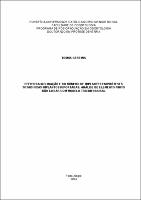| Share record |


|
Please use this identifier to cite or link to this item:
https://tede2.pucrs.br/tede2/handle/tede/5954Full metadata record
| DC Field | Value | Language |
|---|---|---|
| dc.creator | Geremia , Tomás | - |
| dc.creator.Lattes | http://buscatextual.cnpq.br/buscatextual/visualizacv.do?id=K4730198U5 | por |
| dc.contributor.advisor1 | Shinkai , Rosemary Sadami Arai | - |
| dc.date.accessioned | 2015-04-28T14:03:32Z | - |
| dc.date.issued | 2014-08-28 | - |
| dc.identifier.uri | http://tede2.pucrs.br/tede2/handle/tede/5954 | - |
| dc.description.resumo | O objetivo do presente trabalho foi avaliar em reabilitações totais fixas implantossuportadas, através de uma Metodologia de Elementos Finitos não linear, a influência do número e da inclinação dos implantes posteriores em 27 graus para distal nas tensões em osso periimplantar cortical, parafuso do pilar protético e parafuso protético. Seis modelos virtuais foram gerados simulando uma prótese total fixa mandibular, com infraestrutura metálica: modelos com 5 implantes, paralelos entre si (5R) e com dois posteriores inclinados (5I); modelos com 4 implantes, paralelos entre si (4R) e com dois posteriores inclinados (4I); modelos com 3 implantes, paralelos entre si (3R) e com dois posteriores inclinados (3I). Uma força de 100 N foi simulada em região de primeiro molar, no cantilever protético. As tensões Von Mises resultantes foram analisadas de forma qualitativa nas três regiões de interesse.Os resultados mostraram que a utilização de implantes posteriores inclinados resultaram em maiores tensões na região periimplantar. Ainda, que o implante adjacente à carga apresentou os maiores valores de tensão nas três regiões avaliadas em todas as simulações. Dentro das limitações deste trabalho, pode-se concluir que a inclinação de implantes posteriores, sem a distalização das plataformas dos mesmos, mostra-se desfavorável no que diz respeito à incidência de tensões no osso periimplantar cortical. Além disso, a utilização de três implantes suportando uma prótese total fixa mandibular, apresentou maiores valores de tensão se comparado as situações com quatro e cinco implantes. | por |
| dc.description.abstract | The aim of this study was to evaluate the influence of the number of implants and the distal tilting of posterior implants (27 degrees) on the resulting tensions in periimplant bone, abutment screw and prosthetic screw of mandibular full-arch fixed implant supported prosthesis, using a nonlinear finite element analysis. Six virtual models were created, simulating a mandibular full-arch prosthesis with a metallic framework: models with five parallel implants (5R) and with tilted posterior implants (5I); models with four parallel implants (4R) and tilted posterior ones (4I); and models with three parallel implants (3R) and with tilted posterior implants (3I). The Von Mises tensions were analyzed, on a qualitative aspect, on the three regions of interest. The results showed that tilting the posterior implants resulted in higher tensions on the periimplant bone region.Also, the implant placed adjacent to the loading area presented the higher stress magnitudes on the three regions of interest, during all the simulations. Within the limitations of this study, it's possible to conclude that tilting the posterior implants without distalizing the implants platforms, can represent higher Von Mises tensions on the cortical periimplant bone. Still, that the use of three implants supporting a mandibular full-arch prosthesis generated higher stress values on the analyzed regions, when compared to the models simulating four and five implants. | eng |
| dc.description.provenance | Submitted by Setor de Tratamento da Informação - BC/PUCRS ([email protected]) on 2015-04-28T14:03:32Z No. of bitstreams: 1 467680.pdf: 13016515 bytes, checksum: e3ef505603c7d5be9a1581e535fd60e2 (MD5) | eng |
| dc.description.provenance | Made available in DSpace on 2015-04-28T14:03:32Z (GMT). No. of bitstreams: 1 467680.pdf: 13016515 bytes, checksum: e3ef505603c7d5be9a1581e535fd60e2 (MD5) Previous issue date: 2014-08-28 | eng |
| dc.format | application/pdf | * |
| dc.thumbnail.url | http://tede2.pucrs.br:80/tede2/retrieve/17820/467680.pdf.jpg | * |
| dc.language | por | por |
| dc.publisher | Pontifícia Universidade Católica do Rio Grande do Sul | por |
| dc.publisher.department | Faculdade de Odontologia | por |
| dc.publisher.country | Brasil | por |
| dc.publisher.initials | PUCRS | por |
| dc.publisher.program | Programa de Pós-Graduação em Odontologia | por |
| dc.rights | Acesso Aberto | por |
| dc.subject | ODONTOLOGIA | por |
| dc.subject | IMPLANTODONTIA | por |
| dc.subject | PRÓTESE DENTÁRIA | por |
| dc.subject | MANDÍBULA | por |
| dc.subject | IMPLANTES DENTÁRIOS OSSEOINTEGRADOS | por |
| dc.subject | OSSEOINTEGRAÇÃO (ODONTOLOGIA) | por |
| dc.subject.cnpq | CIENCIAS DA SAUDE::ODONTOLOGIA | por |
| dc.title | Efeito da inclinação e do número de implantes em próteses totais fixas implantossuportadas : análise de elemento finito não linear com modelo tridimensional | por |
| dc.type | Tese | por |
| Appears in Collections: | Programa de Pós-Graduação em Odontologia | |
Files in This Item:
| File | Description | Size | Format | |
|---|---|---|---|---|
| 467680.pdf | Texto Completo | 12.71 MB | Adobe PDF |  Download/Open Preview |
Items in DSpace are protected by copyright, with all rights reserved, unless otherwise indicated.




